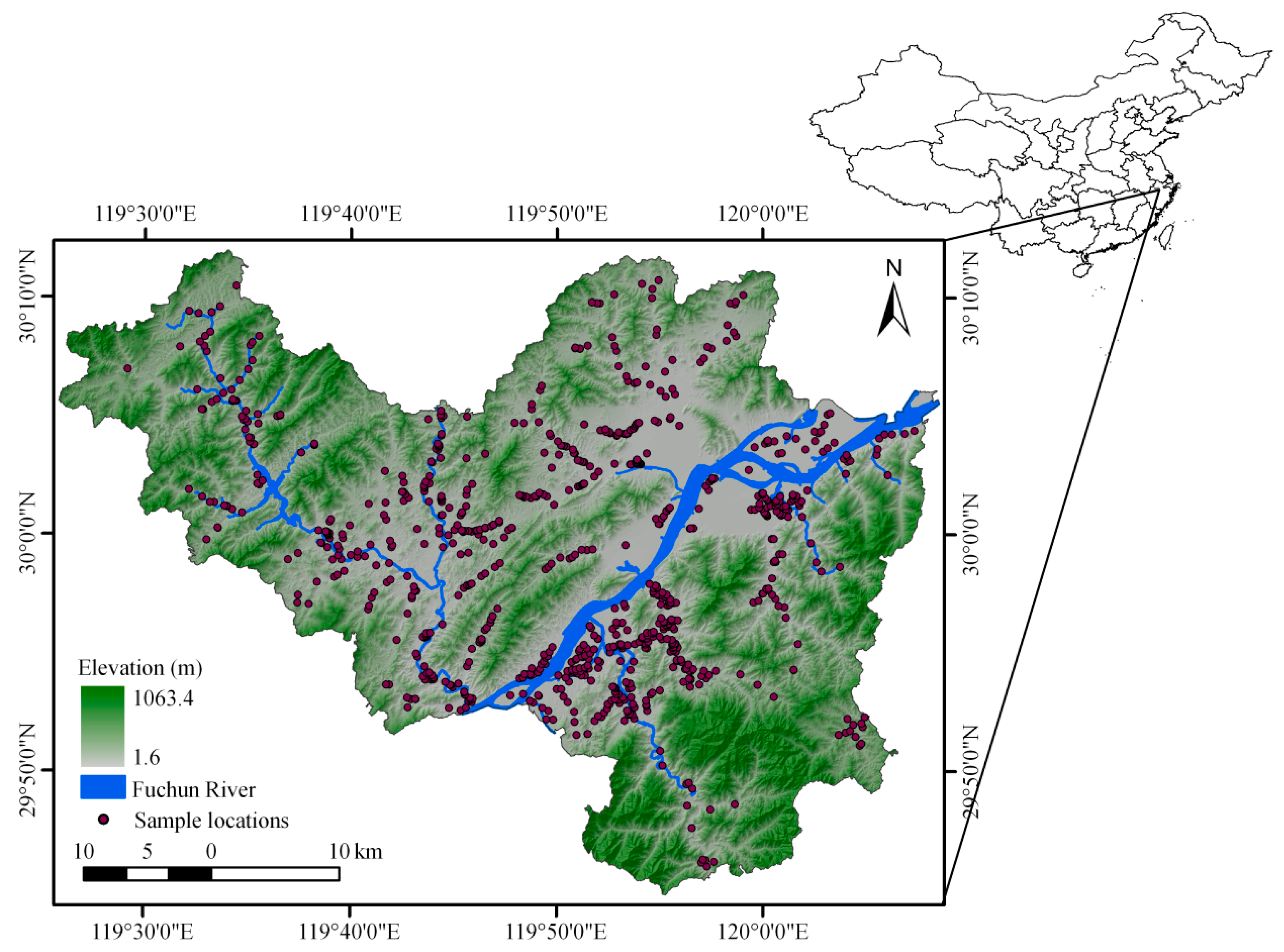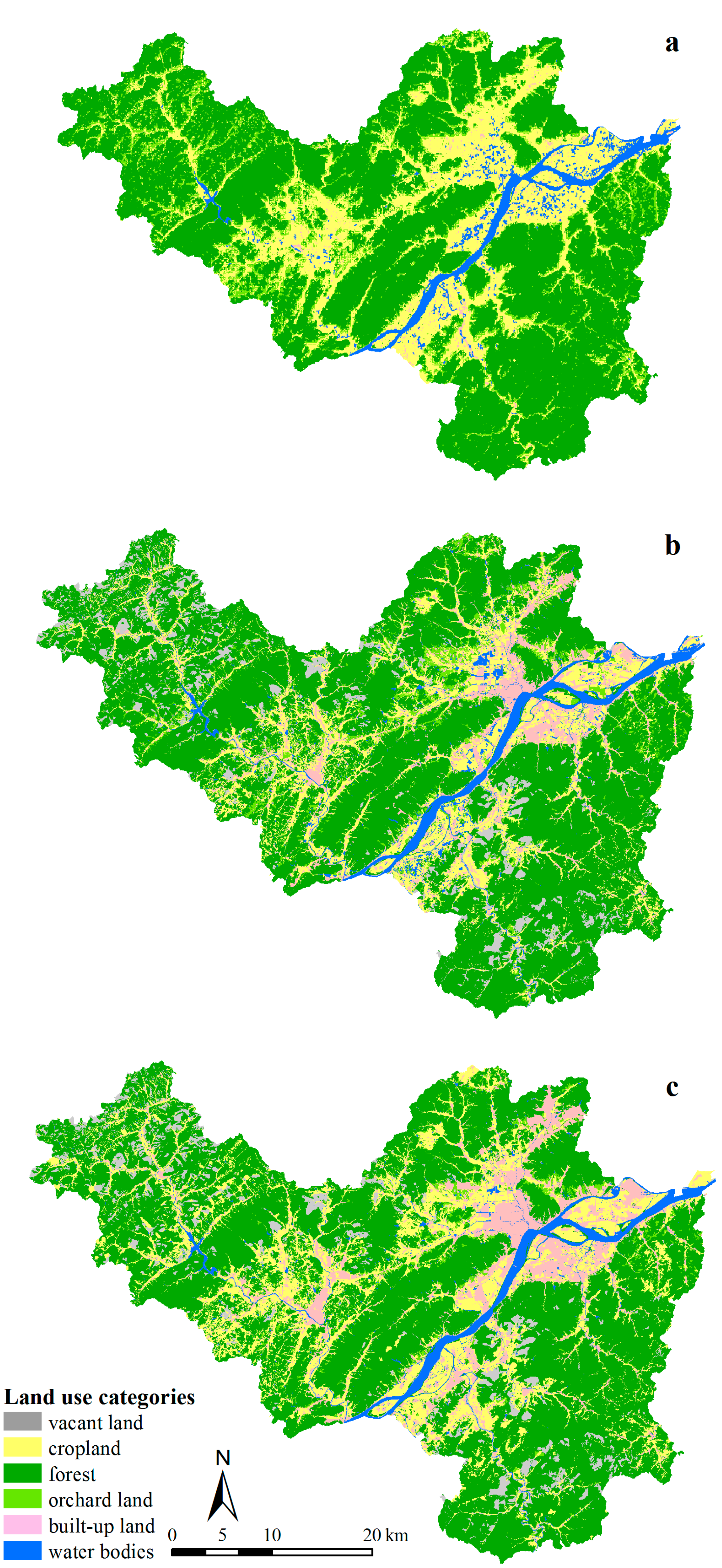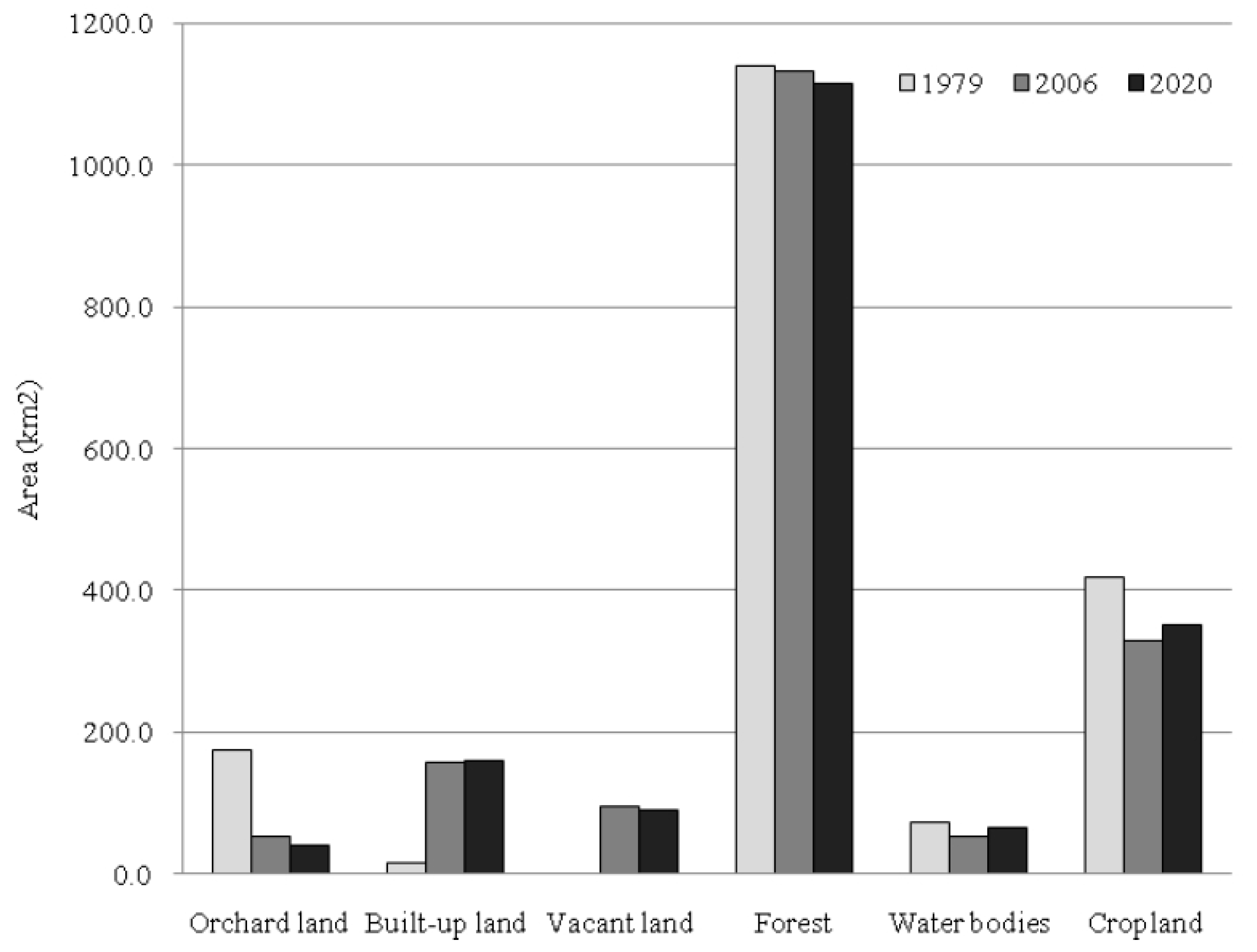Land Use Changes Induced County-Scale Carbon Consequences in Southeast China 1979–2020, Evidence from Fuyang, Zhejiang Province
Abstract
:1. Introduction
2. Materials and Methods
2.1. Study Area

2.2. Carbon Density for Land Use Types

| Land Use Type | Vegetation Carbon Density (Mg ha−1) | References | Soil Carbon Density (Mg ha−1) | References | ||||
|---|---|---|---|---|---|---|---|---|
| XMIN | XMAX | XMIN | XMAX | |||||
| 1 * | - | - | - | - | - | - | - | - |
| 2 | 28.11 | 12.06 | 50.18 | [14,30,31] | 55.54 | 25.25 | 77.77 | [32,33,34,35,36,37,38,39,40,41,42,43,44] |
| 3 | 19.38 | 4.04 | 48.93 | [31,33,35] | 42.35 | 32.68 | 46.2 | [32,33,36] |
| 4 | 1.24 | 0 | 2.3 | [35,37,38] | 16.64 | 4.75 | 27.78 | [39,40,41] |
| 5 | 3.25 | 1.29 | 5.7 | [31,35,38] | 42.5 | 2.4 | 81.6 | - |
| 6 * | - | - | - | - | - | - | - | - |
2.3. Fuyang Land Use Master Planning (2006–2020)
2.4. Data Process
3. Results
3.1. Land Use Changes in Fuyang between 1979 and 2006

| Land Use Classes (1979) | Land Use Classes (2006) | Total Area (1979, km2) | Area Ratio (1979, %) | |||||
|---|---|---|---|---|---|---|---|---|
| 1 | 2 | 3 | 4 | 5 | 6 | |||
| 1 | 4.3 | 1.5 | 0.6 | 0.6 | 8.0 | 0.8 | 15.8 | 0.9 |
| 2 | 18.5 | 960.2 | 17.8 | 74.6 | 66.8 | 2.9 | 1140.7 | 62.6 |
| 3 | 16.6 | 90.3 | 11.9 | 8.9 | 45.0 | 1.4 | 174.1 | 9.6 |
| 5 | 105.8 | 78.4 | 21.6 | 9.5 | 192.6 | 10.0 | 417.8 | 22.9 |
| 6 | 12.4 | 2.7 | 0.6 | 1.5 | 17.7 | 37.8 | 72.7 | 4.0 |
| Total Area (2006, km2) | 157.5 | 1133.1 | 52.6 | 95.1 | 330.0 | 52.8 | 1821.2 | 100.0 |
| Area ratio (2006, %) | 8.6 | 62.2 | 2.9 | 5.2 | 18.1 | 2.9 | 100.0 | - |
3.2. Carbon Stock Changes in Fuyang between 1979 and 2006

| From | To | Total (1979) | |||||
|---|---|---|---|---|---|---|---|
| 1 | 2 | 3 | 4 | 5 | 6 | ||
| 1 | 0.0 * (0.0) ** | 4.3 (8.4) | 1.2 (2.7) | 0.1 (1.0) | 2.6 (34.0) | 0.0 (0.0) | 8.2 (46.1) |
| 2 | −52.1 (−102.9) | 0.0 (0.0) | −15.6 (−23.5) | −200.4 (−290.1) | −165.9 (−87.3) | −8.0 (−15.9) | −442.0 (−519.6) |
| 3 | −32.1 (−70.2) | 78.9 (119.1) | 0.0 (0.0) | −16.1 (−22.9) | −72.5 (0.5) | −2.8 (−6.0) | −44.7 (20.5) |
| 5 | −34.4 (−449.0) | 195.0 (102.6) | 34.8 (−0.2) | −1.9 (−24.7) | 0.0 (0.0) | −3.2 (−42.3) | 190.2 (−413.6) |
| 6 | 0.0 (0.0) | 7.7 (15.1) | 1.2 (2.7) | 0.2 (2.5) | 5.8 (75.3) | 0.0(0.0) | 14.8 (95.5) |
| Total (2006) | −118.5 (−622.0) | 285.7 (245.2) | 21.7 (−18.3) | −218.2 (−334.2) | −230.1 (22.4) | −14.0 (−64.2) | −273.4 (−771.0) |
3.3. Future Land-Use Change and Carbon Sequestration
| Land Use Classes (2006) | Land Use Classes (2020) | Total Area (2006, km2) | Area Ratio (2006, %) | |||||
|---|---|---|---|---|---|---|---|---|
| 1 | 2 | 3 | 4 | 5 | 6 | |||
| 1 | 131.5 | 8.6 | 1.0 | - | 16.3 | - | 157.4 | 8.6 |
| 2 | 2.9 | 1107.3 | - | - | 23.3 | - | 1133.5 | 62.2 |
| 3 | 5.9 | - | 40 | - | 6.7 | - | 52.6 | 2.9 |
| 4 | 0.4 | - | - | 90.2 | 4.5 | - | 95.1 | 5.2 |
| 5 | 18.7 | - | - | - | 298.9 | 12.1 | 329.7 | 18.1 |
| 6 | 0.1 | - | - | - | 0.1 | 52.6 | 52.8 | 2.9 |
| Total Area (2020, km2) | 159.5 | 1115.9 | 41.0 | 90.2 | 349.8 | 64.7 | 1821.2 | 100.0 |
| Area ratio (2020, %) | 8.8 | 61.3 | 2.3 | 5.0 | 19.2 | 3.6 | 100.0 | - |
4. Discussion
4.1. Land Use Changes and Soil Carbon Stocks

4.2. Carbon Balance in Land Use Planning
4.3. Limitations
5. Conclusions
Supplementary Materials
Acknowledgments
Author Contributions
Conflicts of Interest
References
- Celik, I. Land-use effects on organic matter and physical properties of soil in a southern mediterranean highland of turkey. Soil Tillage Res. 2005, 83, 270–277. [Google Scholar] [CrossRef]
- Lax, A.; Diaz, E.; Castillo, V.; Albaladejo, J. Reclamation of physical and chemical properties of a salinized soil by organic amendment. Arid Soil Res. Rehabil. 1994, 8, 9–17. [Google Scholar] [CrossRef]
- Freibauer, A.; Rounsevell, M.D.A.; Smith, P.; Verhagen, J. Carbon sequestration in the agricultural soils of europe. Geoderma 2004, 122, 1–23. [Google Scholar] [CrossRef]
- Ostle, N.J.; Levy, P.E.; Evans, C.D.; Smith, P. UK land use and soil carbon sequestration. Land Use Policy 2009, 26, S274–S283. [Google Scholar] [CrossRef]
- Li, P.; Wang, Q.; Endo, T.; Zhao, X.; Kakubari, Y. Soil organic carbon stock is closely related to aboveground vegetation properties in cold-temperate mountainous forests. Geoderma 2010, 154, 407–415. [Google Scholar] [CrossRef]
- Mishra, U.; Ussiri, D.A.N.; Lal, R. Tillage effects on soil organic carbon storage and dynamics in Corn Belt of Ohio USA. Soil Tillage Res. 2010, 107, 88–96. [Google Scholar] [CrossRef]
- Xu, S.; Shi, X.; Zhao, Y.; Yu, D.; Li, C.; Wang, S.; Tan, M.; Sun, W. Carbon sequestration potential of recommended management practices for paddy soils of China, 1980–2050. Geoderma 2011, 166, 206–213. [Google Scholar] [CrossRef]
- Liu, Y.; Yu, D.; Wang, N.; Shi, X.; Warner, E.D.; Zhang, H.; Qin, F. Impacts of agricultural intensity on soil organic carbon pools in a main vegetable cultivation region of China. Soil Tillage Res. 2013, 134, 25–32. [Google Scholar] [CrossRef]
- Tesfaye, M.A.; Bravo, F.; Ruiz-Peinado, R.; Pando, V.; Bravo-Oviedo, A. Impact of changes in land use, species and elevation on soil organic carbon and total nitrogen in ethiopian central highlands. Geoderma 2016, 261, 70–79. [Google Scholar] [CrossRef]
- Winowiecki, L.; Vågen, T.G.; Huising, J. Effects of land cover on ecosystem services in tanzania: A spatial assessment of soil organic carbon. Geoderma 2016, 263, 274–283. [Google Scholar] [CrossRef]
- Schulp, C.J.E.; Nabuurs, G.J.; Verburg, P.H. Future carbon sequestration in europe-effects of land use change. Agric. Ecosyst. Environ. 2008, 127, 251–264. [Google Scholar] [CrossRef]
- Zaehle, S.; Bondeau, A.; Carter, T.R.; Cramer, W.; Erhard, M.; Prentice, I.C.; Reginster, I.; Rounsevell, M.D.A.; Sitch, S.; Smith, B.; et al. Projected changes in terrestrial carbon storage in europe under climate and land-use change, 1990–2100. Ecosystems 2007, 10, 380–401. [Google Scholar] [CrossRef]
- Batlle-Bayer, L.; Batjes, N.H.; Bindraban, P.S. Changes in organic carbon stocks upon land use conversion in the brazilian cerrado: A review. Agric. Ecosyst. Environ. 2010, 137, 47–58. [Google Scholar] [CrossRef]
- Ren, Y.; Wei, X.; Wei, X.; Pan, J.; Xie, P.; Song, X.; Peng, D.; Zhao, J. Relationship between vegetation carbon storage and urbanization: A case study of Xiamen, China. For. Ecol. Manag. 2011, 261, 1214–1223. [Google Scholar] [CrossRef]
- Hutyra, L.R.; Yoon, B.; Hepinstall-Cymerman, J.; Alberti, M. Carbon consequences of land cover change and expansion of urban lands: A case study in the seattle metropolitan region. Landsc. Urban Plan. 2011, 103, 83–93. [Google Scholar] [CrossRef]
- Rui, W.; Zhang, W. Effect size and duration of recommended management practices on carbon sequestration in paddy field in Yangtze Delta Plain of China: A meta-analysis. Agric. Ecosyst. Environ. 2010, 135, 199–205. [Google Scholar] [CrossRef]
- Fang, X.; Xue, Z.; Li, B.; An, S. Soil organic carbon distribution in relation to land use and its storage in a small watershed of the Loess Plateau, China. Catena 2012, 88, 6–13. [Google Scholar] [CrossRef]
- Fu, X.; Shao, M.; Wei, X.; Horton, R. Soil organic carbon and total nitrogen as affected by vegetation types in northern Loess Plateau of China. Geoderma 2010, 155, 31–35. [Google Scholar] [CrossRef]
- Kong, X.; Dao, T.H.; Qin, J.; Qin, H.; Li, C.; Zhang, F. Effects of soil texture and land use interactions on organic carbon in soils in north China cities’ urban fringe. Geoderma 2009, 154, 86–92. [Google Scholar] [CrossRef]
- Wang, S.; Chen, J.M.; Ju, W.M.; Feng, X.; Chen, M.; Chen, P.; Yu, G. Carbon sinks and sources in China’s forests during 1901–2001. J. Environ. Manag. 2007, 85, 524–537. [Google Scholar] [CrossRef] [PubMed]
- He, N.; Yu, Q.; Wu, L.; Wang, Y.; Han, X. Carbon and nitrogen store and storage potential as affected by land-use in a Leymus chinensis grassland of northern China. Soil Biol. Biochem. 2008, 40, 2952–2959. [Google Scholar] [CrossRef]
- Tao, T.; Tan, Z.; He, X. Integrating environment into land-use planning through strategic environmental assessment in China: Towards legal frameworks and operational procedures. Environ. Impact Assess. Rev. 2007, 27, 243–265. [Google Scholar] [CrossRef]
- Ministry of Land and Resources of China. Land use master planning of Zhejiang province. Available online: http://www.mlr.gov.cn/tdsc/tdgh/201011/t20101102_791712.htm (accessed on 31 December 2015).
- Qiu, L.F.; Zhu, J.X.; Zhu, Y.H.; Hong, Y.; Wang, K.; Deng, J.S. Land use changes induced soil organic carbon variations in agricultural soils of Fuyang County, China. J. Soils Sediments 2013, 13, 981–988. [Google Scholar] [CrossRef]
- Ministry of Land and Resources of China. The key data results of the second national land survey in Zhejiang province. Available online: http://www.mlr.gov.cn/tdzt/tdgl/decdc/dccg/gscg/201407/t20140724_1324788.htm (accessed on 31 December 2015).
- Cantarello, E.; Newton, A.C.; Hill, R.A. Potential effects of future land-use change on regional carbon stocks in the UK. Environ. Sci. Policy 2011, 14, 40–52. [Google Scholar] [CrossRef]
- Munoz-Rojas, M.; de la Rosa, D.; Zavala, L.M.; Jordan, A.; Anaya-Romero, M. Changes in land cover and vegetation carbon stocks in Andalusia, Southern Spain (1956–2007). Sci. Total Environ. 2011, 409, 2796–2806. [Google Scholar] [CrossRef] [PubMed]
- Walkley, A.; Black, I.A. An examination of the degtjareff method for determining soil organic matter, and a proposed modification of the chromic acid titration method. Soil Sci. 1934, 37, 29–38. [Google Scholar] [CrossRef]
- Schwager, S.J.; Mikhailova, E.A. Estimating variability in soil organic carbon storage using the method of statistical differentials. Soil Sci. 2002, 167, 194–200. [Google Scholar] [CrossRef]
- Pan, Y.D.; Luo, T.X.; Birdsey, R.; Hom, J.; Melillo, J. New estimates of carbon storage and sequestration in China’s forests: Effects of age-class and method on inventory-based carbon estimation. Clim. Chang. 2004, 67, 211–236. [Google Scholar] [CrossRef]
- Li, Z.C. The effects of land-use change on the soil organic carbon. Ph.D. Thesis, Chinese Academy of Forestry, Beijing, China, 2006. [Google Scholar]
- Li, Z.C.; Xu, D.Y.; Fu, M.y.; Sun, X.Z.; Xi, J.R. Effects of land-use change on vertical distribution and storage of soil organic carbon in north subtropical areas. For. Res. 2007, 20, 744–749. (In Chinese) [Google Scholar]
- Li, S.; Wu, X.; Xue, H.; Gu, B.; Cheng, H.; Zeng, J.; Peng, C.; Ge, Y.; Chang, J. Quantifying carbon storage for tea plantations in China. Agric. Ecosyst. Environ. 2011, 141, 390–398. [Google Scholar] [CrossRef]
- Gao, Z.Q.; Fu, M.Y. Characteristics of seasonal changes in soil carbon and nitrogen nutrients of different phyllostachys pubescens stands. J. Zhejiang For. Coll. 2006, 23, 248–254. (In Chinese) [Google Scholar]
- Li, K.R.; Wang, S.Q.; Cai, M.K. Vegetation and soil carbon storage in China. Sci. China Ser. D 2003, 33, 72–80. (In Chinese) [Google Scholar] [CrossRef]
- Li, S.Y. Carbon balance of tea plantation ecosystem in China. Ph.D. Thesis, Zhejiang University, Hangzhou, China, 2010. [Google Scholar]
- Wang, S.Q.; Zhou, C.H.; Luo, C.W. Studying carbon storage spatial distribution of terrestrial natural vegetation in China. Prog. Geogr. 1999, 18, 238–244. (In Chinese) [Google Scholar]
- Jiang, Q.O.; Deng, X.Z.; Zhang, J.Y.; Liu, X.Q. Impacts of cultivated land conversion on the vegetation carbon storage in the Huang-Huai-Hai Plain. Geogr. Res. 2008, 27, 839–846. (In Chinese) [Google Scholar]
- Peng, X.H.; Zhang, B.; Zhao, Q.G. Effect of soil organic carbon on aggregates stability after vegetative restoration on severely eroded red soil. Acta Ecol. Sin. 2003, 23, 2176–2183. (In Chinese) [Google Scholar]
- Liu, S.Z.; Guo, S.L.; Wang, X.L.; Xue, B.M. Effect of vegetation on soil organic carbon of slope land in gully region of Loess Plateau. J. Natl. Resour. 2005, 20, 529–536. (In Chinese) [Google Scholar]
- Li, Z.P. Density of soil organic carbon pool and its variation in hilly red soil region. Soils 2004, 36, 292–297. (In Chinese) [Google Scholar]
- Bellamy, P.H.; Loveland, P.J.; Bradley, R.I.; Lark, R.M.; Kirk, G.J.D. Carbon losses from all soils across England and Wales 1978–2003. Nature 2005, 437, 245–248. [Google Scholar] [CrossRef] [PubMed] [Green Version]
- Gao, J.; Pan, G.; Jiang, X.; Pan, J.; Zhuang, D. Land-use induced changes in topsoil organic carbon stock of paddy fields using MODIS and TM/ETM analysis: A case study of Wujiang County, China. J. Environ. Sci. 2008, 20, 852–858. [Google Scholar] [CrossRef]
- Boix-Fayos, C.; de Vente, J.; Albaladejo, J.; Martínez-Mena, M. Soil carbon erosion and stock as affected by land use changes at the catchment scale in mediterranean ecosystems. Agric. Ecosyst. Environ. 2009, 133, 75–85. [Google Scholar] [CrossRef]
- Yang, H. Land conservation campaign in China: Integrated management, local participation and food supply option. Geoforum 2004, 35, 507–518. [Google Scholar] [CrossRef]
- Ministry of Land and Resources of China. Land Resources Bulletin 2008. Available online: http://www.mlr.gov.cn/zwgk/tjxx/200912/t20091215_699769.htm (accessed on 30 December 2015).
- Fang, J.; Chen, A.; Peng, C.; Zhao, S.; Ci, L. Changes in forest biomass carbon storage in China between 1949 and 1998. Science 2001, 292, 2320–2322. [Google Scholar] [CrossRef] [PubMed]
- Eynard, A.; Schumacher, T.E.; Lindstrom, M.J.; Malo, D.D. Effects of agricultural management systems on soil organic carbon in aggregates of Ustolls and Usterts. Soil Tillage Res. 2005, 81, 253–263. [Google Scholar] [CrossRef]
- Wagai, R.; Mayer, L.M.; Kitayama, K.; Knicker, H. Climate and parent material controls on organic matter storage in surface soils: A three-pool, density-separation approach. Geoderma 2008, 147, 23–33. [Google Scholar] [CrossRef]
© 2015 by the authors; licensee MDPI, Basel, Switzerland. This article is an open access article distributed under the terms and conditions of the Creative Commons by Attribution (CC-BY) license (http://creativecommons.org/licenses/by/4.0/).
Share and Cite
Qiu, L.; Zhu, J.; Wang, K.; Hu, W. Land Use Changes Induced County-Scale Carbon Consequences in Southeast China 1979–2020, Evidence from Fuyang, Zhejiang Province. Sustainability 2016, 8, 38. https://doi.org/10.3390/su8010038
Qiu L, Zhu J, Wang K, Hu W. Land Use Changes Induced County-Scale Carbon Consequences in Southeast China 1979–2020, Evidence from Fuyang, Zhejiang Province. Sustainability. 2016; 8(1):38. https://doi.org/10.3390/su8010038
Chicago/Turabian StyleQiu, Lefeng, Jinxia Zhu, Ke Wang, and Wei Hu. 2016. "Land Use Changes Induced County-Scale Carbon Consequences in Southeast China 1979–2020, Evidence from Fuyang, Zhejiang Province" Sustainability 8, no. 1: 38. https://doi.org/10.3390/su8010038





